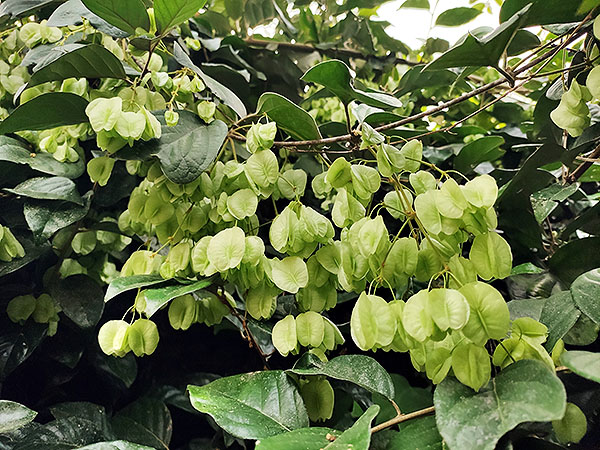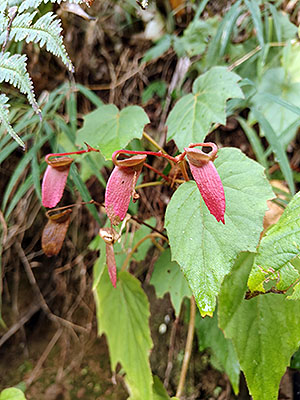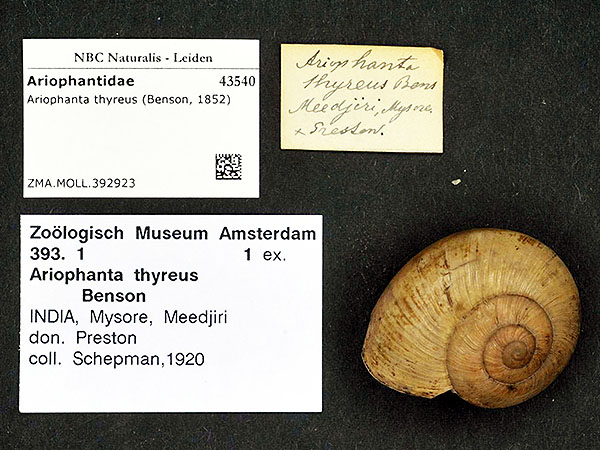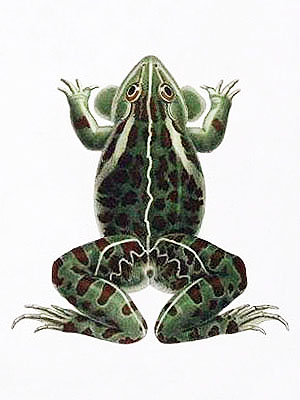Neighboring Sedge (Carex vicinalis)
This sedge was described in 1867; it is known only from the type material that was collected somewhere in the Nilgiri Hills in Tamil Nadu, India.
The species might be extinct.
*********************
edited: 15.08.2022
Tag Archives: India
Carex sahnii Ghildyal & U. C. Bhattach.
King’s Sedge (Carex sahnii)
This species was described in 1986; it is known only from the type material that was collected at a place named Pheedong in Sikkim, India.
The species might now be extinct.
***
syn. Carex kingiana C. B. Clarke
*********************
edited: 15.08.2022
Ampelocissus helferi (M. A. Lawson) Planch.
Helfer’s Ampelocissus Wine (Ampelocissus helferi)
This climbing wine was described in 1887; it inhabits the forests of the Andaman Islands in the north-eastern Indian Ocean.
The species is known from only two collections that were both made around the same time; it might be still existing but is mentioned here for the sake of completeness.
***
syn. Vitis helferi M. A. Lawson
*********************
edited: 15.08.2022
Selaginella cataractarum Alston
Down-pouring Spikemoss (Selaginella cataractarum)
This species is known from Tamil Nadu, India; it is now apparently extinct.
***
The photo below shows some unspecified Spikemoss species that was photographed in Tamil Nadu, India.
*********************

Photo: Deepika
https://www.inaturalist.org/people/vpdeepika
https://creativecommons.org/licenses/by-nc/4.0/
*********************
References:
[1] Atsushi Ebihara; Christopher Roy Fraser-Jenkins; Barbara S. Parris; Xian-Chun Zhang; Yue-Hong Yang; Wen-Liang Chiou; Ho-Ming Chang; Stuart Lindsay; David Middleton; Masahiro Kato; Titien Ngatinem Praptosuwiryo; Victor B. Amoroso; Julie F. Barcelona; Rajapaksha Haddokara Gedara Ranil; Chan-Ho Park; Noriaki Murakami; Akihiko Hoya: Rare and Threatened Pteridophytes of Asia 1. An Enumeration of Narrowly Distributed Taxa1. Bulletin of the National Museum of Nature and Science, Ser. B 38(3): 93–119. 2012
*********************
edited: 12.02.2024
Drimia polyphylla (Hook. f.) Ansari & Sundararagh
Many-leaved Drimia (Drimia polyphylla)
The Many-leaved Drimia was described in 1980; it is, or maybe was, endemic to the hill slopes of the Deccan Plateau in Maharashtra, India.
The species was not seen since over 120 years and might well be extinct.
***
syn. Indurgia polyphylla (Hook. f.) Speta, Thuranthos polyphyllus (Hook. f.) Speta, Urginea polyphylla Hook. f.
*********************
edited: 20.08.2022
Dicliptera abuensis Blatt.
Mt. Abu Dicliptera (Dicliptera abuensis)
The Mt. Abu Dicliptera was described in 1931; the species is known only from the type that was collected in 1916.
The species was endemic to the Dhobi Ghats at Mount Abu in Rajasthan, India, where it inhabited wet and shady habitats.
***
The photo below shows a related taxon, the Panicled Foldwing (Dicliptera paniculata (Forssk.) I. Darbysh.), which is also found in Rajasthan, India.
*********************

Photo: Sonu Kumar
https://www.inaturalist.org/people/sonukumar055
https://creativecommons.org/licenses/by-nc/4.0/
*********************
edited: 12.02.2024
Calamus dilaceratus Becc.
Lacerating Calamus Palm (Calamus dilaceratus)
This palm species was described in 1902; it is apparently endemic to Great Nicobar Island in the Nicobar Islands group in the Indian Ocean.
The species is known only by its type, which had been collected in 1888, it is very likely extinct now.
***
The photo below shows an unspecified congeneric species that was photographed on the Nicobar Islands.
*********************

Photo: Jonathan M
https://www.inaturalist.org/people/isidoreajar
https://creativecommons.org/licenses/by-nc/4.0/
*********************
edited: 05.02.2024
Aspidopterys tomentosa var. hutchinsonii R. C. Srivast.
Hutchinson’s Tomentose Aspidopterys Liana (Aspidopterys tomentosa var. hutchinsonii)
This variety of the Tomentose Aspidopterys Liana (Aspidopterys tomentosa (Blume) A. Juss.) (see photo below) was described in 1985; it is only known from the type material that was found in 1937 (?) somewhere in the Mayurbhanj Hills in Odisha, India.
The plant was never found again since and might well be extinct now.
***
syn. Aspidopterys hutchinsonii Haines
*********************

Photo: Liu Guangyu
https://www.inaturalist.org/people/liuguangyu
https://creativecommons.org/licenses/by-nc/4.0/
*********************
edited: 15.01.2024
Begonia wengeri C. E. C. Fisch.
Wenger’s Begonia (Begonia wengeri)
Wenger’s Begonia was described in 1932; it is apparently known exclusively from the type material which was collected on moist shady banks along water bodies in the undergrowth of the evergreen forests in the southern Lushai Hills in Mizoram, India.
The species was not found since and might be extinct.
***
The photo below shows another, unspecified congeneric species that was photographed in Mizoram, India.
*********************

Photo: Kedar
https://www.inaturalist.org/people/kedartambe
https://creativecommons.org/licenses/by-nc/4.0/
*********************
edited: 15.08.2022
Cissus notabilis Doweld
Remarkable Cissus Wine (Cissus notabilis)
This species was described in 1887; it is known only from two collection that both were obtained some 125 years ago, one in West Bengal and the other one in Sikkim, India.
The species was an erect shrub that grew in damp forests, it might well be extinct.
***
syn. Cissus spectabilis (Kurz) Hochst. ex Planch.
*********************
edited: 20.08.2022
Dipcadi minor Hook. f.
The Small Dipcadi, described in 1892, is known only from material that was collected in 1859 somewhere on the Deccan Plateau; it has never been found again since and is probably extinct.
*********************
edited: 20.08.2022
Rhinolophus mitratus Blyth
Mitred Horseshoe Bat (Rhinolophus mitratus)
The Mitred Horseshoe Bat is a very enigmatic species only known from the type that was collected in 1844 somewhere in Jharkhand, India.
The species might indeed be still around and may be rediscovered some day, but until that happens it should be mentioned in here.
*********************
edited: 19.09.2020
Prismatomeris fragrans ssp. andamanica (Ridl.) J. T. Johanss.
This subspecies of the Fragrant Prismatomeris (Prismatomeris fragrans E. T. Geddes) was originally described as a distinct species in 1940; as its name implies, it is restricted to the Andaman Islands.
This plant was not found recently and is thought to be possibly extinct.
*********************
edited: 24.08.2022
Euphlyctis ghoshi (Chanda)
Manipur Frog (Euphlyctis ghoshi)
The Manipur Frog was described in 1990 on the basis of the type specimen which had been collected in 1975 in the Khugairk Reserve Forest in Manipur, India, a locality that apparently doesn’t exist.
However; the species has never been recorded since 1975 and may well be extinct.
*********************
edited: 11.02.2024
Seseli alboalatum (Haines) Pimenov & Kljuykov
White-winged Stone-Parsley (Seseli alboalatum)
The White-winged Stone-Parsley, described in 1919, is a small herb with white flowers and is known from only two regions, the hills of Chotanagpur on the Neterahat Plateau in the Ranchi District, Jharkhand as well as from the Raigarh District in Chhattisgarh, both in north-eastern India.
The species was last recorded in 1940 and is now considered to be very likely extinct.
***
syn. Ligusticum alboalatum Haines
*********************

(public domain)
*********************
References:
[1] Sharad Singh Negi: Biodiversity and its conservation in India. South Asia Books 1993
*********************
edited: 12.02.2024
Ariophanta thyreus (Benson)
The Thyreus Snail was described in 1852; it was known from several places in the Nilgiri Mountains in southern India.
The shells on average reach sizes of about 3,5 cm in diameter; they are of a horny brown color and often have a narrow dark rufous band below the subangulate periphery.
The species is now considered possibly extinct. [1]
*********************
References:
[1] Robert H. Cowie; Claire Régnier; Benoît Fontaine; Philippe Bouchet. Measuring the Sixth Extinction: what do mollusks tell us? The Nautilus 131(1): 3-41. 2017
*********************

Photo: Naturalis Biodiversity Center
https://www.naturalis.nl
(no copyright)
*********************
edited: 22.04.2022
Eremogone ferruginea (Duthie ex Williams) Rabeler & W. L. Wagner
Rusty Sandwort (Eremogone ferruginea)
The Rusty Sandwort (originally described as Arenaria ferruginea Duthie ex F. N. Williams [1]) was restricted to the valleys of the rivers Dhauli and Kali in the Kumaon Division of Uttarakhand, India, it is known exclusively from material that had been collected in 1886 and is most likely extinct.
The species probably disappeared due to heavy grazing by feral ungulates.
*********************
References:
[1] Richard K. Rabeler; Warren L. Wagner: Eremogone (Caryophyllaceae): new combinations for Old World species. PhytoKeys 50: 35-42. 2015
*********************
edited: 14.04.2019
Carex repanda C. B. Clarke
Arched Sedge (Carex repanda)
The Arched sedge was described in 1894, it is, or maybe, was apparently restricted to the Khasi Hills, a low mountain formation on the Shillong Plateau in Meghalaya, India. [1]
the species appears to be extinct now.
*********************
[1] Joseph Dalton Hooker: The flora of British India. London: L. Reeve 1875-1897
*********************
edited: 21.09.2020
Eragrostis rottleri Stapf
Rottler’s Lovegrass (Eragrostis rottleri)
Rottler’s Lovegrass is known exclusively by the type material which was collected already in 1779 somewhere in the vicinity of the city of Tharangambadi (formerly Tranquebar) at the eastern coast of Tamil Nadu, India.
This species is certainly extinct.
*********************
edited: 20.08.2022
Oreogrammitis austroindica (Parris) Parris
South Indian Grammitis Fern (Oreogrammitis austroindica)
The South Indian Grammitis Fern was described in 2001; it is known only from the type material that had been collected in the 19th century in Tamil Nadu, India.
The species might now be extinct.
*********************
References:
[1] Atsushi Ebihara; Christopher Roy Fraser-Jenkins; Barbara S. Parris; Xian-Chun Zhang; Yue-Hong Yang; Wen-Liang Chiou; Ho-Ming Chang; Stuart Lindsay; David Middleton; Masahiro Kato; Titien Ngatinem Praptosuwiryo; Victor B. Amoroso; Julie F. Barcelona; Rajapaksha Haddokara Gedara Ranil; Chan-Ho Park; Noriaki Murakami; Akihiko Hoya: Rare and Threatened Pteridophytes of Asia 1. An Enumeration of Narrowly Distributed Taxa1. Bulletin of the National Museum of Nature and Science, Ser. B 38(3): 93–119. 2012
*********************
edited: 02.05.2022
Angelica nubigena (C. B. Clarke) P. K. Mukh.
Cloud-born Angelica (Angelica nubigena)
This species is only poorly known, only two or three herbarium specimens that were collected in Sikkim, India, where it was found at elevations of about 3500 m above sea level.
The species was last collected in 1849 and is now considered extinct.
*********************
edited: 02.05.2021
Sterculia khasiana Debb.
Khasi Sterkulia (Sterculia khasiana)
This tree species was restricted to the subtropical forests growing on the Khasi Hills in Meghalaya, India.
The species is known from three collections, all made in the 19th century, with the last one dating to 1877; since then the tree could not be relocated and thus is now considered most likely extinct.
*********************
edited: 25.05.2021
Pavetta oblanceolata Bremek.
Oblanceolate Pavetta (Pavetta oblanceolata)
The Oblanceolate Pavetta is known only from the type material which was collected in 1847 in Kerala, India.
It was a shrub with terete branches and 17 cm long and 5 cm wide oblanceolate, shortly acuminate leaves, the flowers appeared in terminal, short peduncled cymes and were about 3 cm long and greenish-white.
The species appeares to be extinct. [1]
*********************
References:
[1] Sharad Singh Negi: Biodiversity and Its Conservation in India. Indus Publishing 1993
*********************
edited: 19.06.2020
Anaphalis barnesii C. E. C. Fisch
Barnes’ Pearly Everlasting (Anaphalis barnesii)
Barnes’ Pearly Everlasting was described in 1939; it is known exclusively by its type collection.
The species inhabited the high altitude grasslands of the Western Ghats in the Idukki District of Kerala, India.
*********************
edited: 15.08.2022
Acronema evolutum (C. B. Clarke) H. Wolff
Naga Pimpernel (Acronema evolutum)
The Naga Pimpernel is known only from the type material, that is said to have been collected in 1985 at the Naga Hills in Nagaland, India.
The species was apparently never recorded since and is thus considered most likely extinct, it is, however, almost always listed under its old synonym Pimpinella evoluta (C. B. Clarke) M. Hiroe. [1]
*********************
References:
[1] Sharad Singh Negi: Biodiversity and its conservation in India. New Delhi: Indus Publishing 1993
*********************
edited: 04.09.2019
Trachyspermum villosum (Haines) P. K. Bhattach. & K. Sarkar
Hairy Carrot (Trachyspermum villosum)
The Hairy Carrot was endemic to sandstone hills of Ramnagar in the northern Champaran District of Bihar, India.
The species is known exclusively from the type specimen that had been collected in 1916, it was not recorded since that time and is most likely extinct today.
*********************
edited: 14.04.2019
Pimpinella pulneyensis Gamble
Pulney Pimpernel (Pimpinella pulneyensis)
The Pulney Pimpernel, described in 1919, was restricted to the Western Ghats in Tamil Nadu, India, the plant was formerly used by several of the native tribes as a medical plant to treat hemorrhoids (?).
The species was last recorded in 1891 and is now considered most likely extinct.
*********************
References:
[1] Sharad Singh Negi: Biodiversity and its conservation in India. New Delhi: Indus Publishing 1993
*********************
edited: 04.09.2019
Asparagus rottleri Baker
Rottler’s Asparagus was described in 1875; the species is thought to be endemic to the Deccan Peninsula, India.
The species is known exclusively from the type collection.
*********************
edited: 12.08.2022
Begonia brevicaulis A. DC.
Short-stemmed Begonia (Begonia brevicaulis)
The Short-stemmed Begonia was described in 1859, it is, or maybe was, endemic to the state of Megalhaya, India, where it was found growing at elevations of about 300 m.
The plant had a bulbous root system, was completely stem-less and had heart-shaped, browdly ovate leaves.
The species is now considered likely extinct.
***
The species should not be mistaken for Begonia brevicaulis T. C. Ku, which is a synonym of the Chinese Begonia sinobrevicaulis T. C. Ku.
*********************
edited: 04.09.2019
Rana brama Lesson
Braman Frog (Rana brama)
The enigmatic braman Frog is known exclusively from a single illustration (shown here), which, however, may or may not correspond to a specimen that is kept in the National Museum of Natural History in France.
The species is believed to originate from an area somewhere between Bangladesh and India.
The Braman Frog may actually never have existed as a distinct species, however, I’d like to list it here as well, since it’s name often appears in listings of extinct animals.
*********************

(not in copyright)
*********************
edited: 11.05.2019
Cryptocarya ferrarsii King ex Hook. f.
The Andaman Cryptocarya, a little tree described in 1886, is known only from the type collection that was made on Middle Andaman Island in the Andamans, India.
The species has not seen since and is believed to be extinct.
*********************
edited: 13.11.2021
Polystichum wattii (Bedd.) C. Chr.
Watt’s Shield Fern (Polystichum wattii)
Watt’s Shield Fern had a restricted distribution in the east part of the Indian state of Manipur, where it was found growing at ca. 1800 m altitude.
The species is now thought to be extinct.
*********************
References:
[1] Subhash Chandra; C. R. Fraser-Jenkins; Alka Kumari; Archana Srivastava: A Summary of the Status of Threatened Pteridophytes of India. Taiwania 52(2): 170-209. 2008
[2] C. R. Fraser-Jenkins: Endemics and Pseudo-Endemics in Relation to the Distribution Pattern of Indian Pteridophytes. Taiwania 53(3): 264-292. 2008
*********************
edited: 20.10.2016
